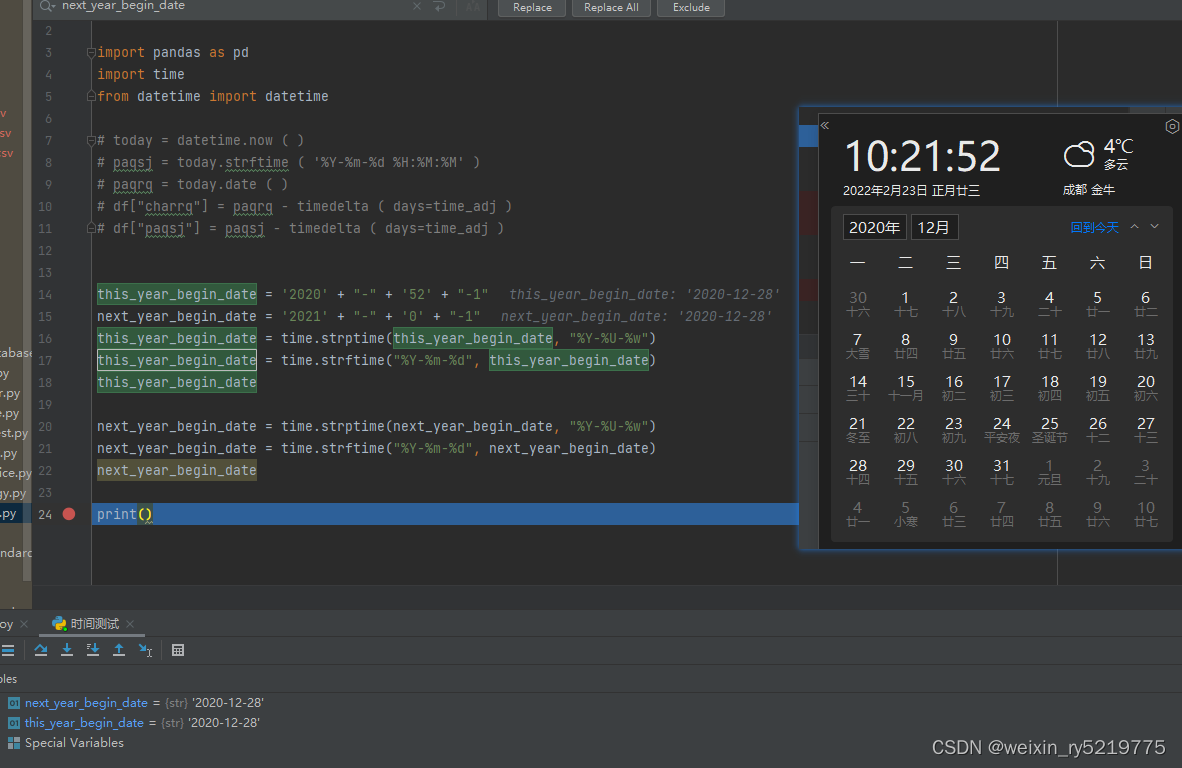20220426
https://blog.csdn.net/m0_46128639/article/details/121975381
pandas时间处理函数
20220324
https://mp.weixin.qq.com/s/zd_8LLgJTNx6iav8-yTcEQ
python处理日期时间库汇总
https://blog.csdn.net/eylier/article/details/111145748
阴历阳历转换
https://pypi.org/project/chinesecalendar/
中国节假日识别,不是很准确
20220223

this_year_begin_date = '2020' + "-" + '52' + "-1"
next_year_begin_date = '2021' + "-" + '0' + "-1"
this_year_begin_date = time.strptime(this_year_begin_date, "%Y-%U-%w")
this_year_begin_date = time.strftime("%Y-%m-%d", this_year_begin_date)
this_year_begin_date
next_year_begin_date = time.strptime(next_year_begin_date, "%Y-%U-%w")
next_year_begin_date = time.strftime("%Y-%m-%d", next_year_begin_date)
next_year_begin_date
当两年交界的一周同时含有两年的天数时候,前一年的最后一周
与下一年的第0周实际上指的同一周
ValueError: day of year out of range
减一周就好了
20211216
from datetime import datetime
today = datetime.now()
day = today.day
20211130
时间周序号对齐包括跨年
见工程化
############
today = pd.to_datetime(run_date)
this_year_begin_date,this_year_end_date,last_year_begin_date,last_year_end_date = utils.confirm_date_range(today)
def cross_year(this_year_begin_week_num,this_year):
'''
:param this_year_begin_week_num: 末尾周序号减周间隔的差值
:param this_year: 当年年份
:return: 确定是当年开始周序号
'''
this_year_begin_date_confirm = ''
# 如果取的时间跨年了
if this_year_begin_week_num < 0:
begin_week_year = int(this_year) - 1
begin_week_year = str(begin_week_year)
max_date = begin_week_year + '-12-31'
max_date = pd.to_datetime(max_date)
max_week_num = max_date.isocalendar()[1]
this_year_begin_week_num = max_week_num - abs(this_year_begin_week_num)
this_year_begin_week_num = str(this_year_begin_week_num)
this_year_begin_date = begin_week_year + "-" + this_year_begin_week_num + "-1"
this_year_begin_date = time.strptime(this_year_begin_date, "%Y-%U-%w")
this_year_begin_date = time.strftime("%Y-%m-%d", this_year_begin_date)
this_year_begin_date_confirm = this_year_begin_date
else:
this_year_begin_week = this_year_begin_week_num
this_year_begin_week = str(this_year_begin_week)
this_year_begin_date = this_year + "-" + this_year_begin_week + "-1"
this_year_begin_date = time.strptime(this_year_begin_date, "%Y-%U-%w")
this_year_begin_date = time.strftime("%Y-%m-%d", this_year_begin_date)
this_year_begin_date_confirm = this_year_begin_date
return this_year_begin_date_confirm
def confirm_date_range(today):
'''
:param today: 输入的日期
:return: 返回确认的取数时间范围
'''
# 返回上一周的周日日期
last_sunday_date = utils.check_sunday(today)
this_year = last_sunday_date.year
this_year = str(this_year)
this_year_end_week_num = last_sunday_date.isocalendar()[1]
this_year_begin_week_num = this_year_end_week_num - 7
this_year_begin_date = cross_year(this_year_begin_week_num,this_year)
this_year_end_date = deepcopy(last_sunday_date)
last_year = int(this_year) -1
last_year = str(last_year)
last_year_end_week_num = this_year_end_week_num
last_year_begin_week_num = this_year_begin_week_num -1
last_year_begin_date = cross_year(last_year_begin_week_num,last_year)
last_year_end_week_num = str(last_year_end_week_num)
last_year_end_date = last_year + "-" + last_year_end_week_num + "-0"
last_year_end_date = time.strptime(last_year_end_date, "%Y-%U-%w")
last_year_end_date = time.strftime("%Y-%m-%d", last_year_end_date)
return (
this_year_begin_date,
this_year_end_date,
last_year_begin_date,
last_year_end_date,
20211118
today = datetime.now()
today = today.date()
today = pd.to_datetime('2021-11-01')
today = utils.check_monday(today)
this_year = today.year
this_year = str(this_year)
# 检查是否为周一,不是就运行上一个周一
this_year_end_week_num = today.isocalendar()[1] - 1
this_year_begin_week_num = this_year_end_week_num - 6
this_year_week_range = [this_year_begin_week_num,this_year_end_week_num]
this_year_begin_week = this_year_begin_week_num
this_year_begin_week = str(this_year_begin_week)
this_year_begin_date = this_year + '-' + this_year_begin_week + "-1"
this_year_begin_date = time.strptime(this_year_begin_date,'%Y-%U-%w')
this_year_begin_date = time.strftime('%Y-%m-%d',this_year_begin_date)
# 上一个周日
this_year_end_date = utils.get_recent_sunday(today)
this_year_end_date = this_year_end_date.date()
last_year = this_year_end_date.year - 1
last_year = str(last_year)
last_year_end_date = this_year_end_date
last_year_end_date = str(last_year_end_date)
last_year_end_date = last_year_end_date[4:]
last_year_end_date = last_year + last_year_end_date
last_year_end_date = pd.to_datetime(last_year_end_date)
last_year_begin_date = deepcopy(this_year_begin_date)
last_year_begin_date = str(last_year_begin_date)
last_year_begin_date = last_year_begin_date[4:]
last_year_begin_date = last_year + last_year_begin_date
last_year_begin_date = pd.to_datetime(last_year_begin_date)
last_year_begin_date = last_year_begin_date - pd.Timedelta(6,unit='D')
无法直接对年进行加减,需要拼接
https://blog.csdn.net/badassname11/article/details/118160189
%Y 四位数的年份表示(000-9999)
%U 一年中的星期数(00-53)星期天为星期的开始
%w 星期(0-6),星期天为星期的开始
通过周序号获得所对应的日期
20211022
https://blog.csdn.net/u014401742/article/details/90592739
时间戳格式化
一、时间datetime
In [10]: pd.datetime(2018,4,1)
Out[10]: datetime.datetime(2018, 4, 1, 0, 0)
二、时间戳Timestamp
表示时间轴上的一个时刻。它提供了方便的时区转换功能。
调用Timestamp()创建任意时间点:
In [98]: pd.Timestamp('2018-08-1 08:02:35')
Out[98]: Timestamp('2018-08-01 08:02:35')
三、时间段Period
Period表示一个标准的时间段。例如某年、某月、某日、某小时等。时间的长短由freq决定。
调用Period()创建任意时间段:
In [100]: pd.Period('2018-08-1 08:02:35',freq='M')
Out[100]: Period('2018-08', 'M')
四、时间间隔Timedetla
通过调用pd.Timedelta()之间创建时间间隔Timedelta对象:
In [102]: pd.Timedelta(weeks=2,days=10,hours=12,minutes=2.4,seconds=10.3)
Out[102]: Timedelta('24 days 12:02:34.300000')
五、时间对象之间的转换
时间戳Timestamp转换为时间段Period
In [104]: pd.Timestamp('2018-08-1 08:02:35').to_period(freq='S')
Out[104]: Period('2018-08-01 08:02:35', 'S')
时间段Period转换为时间戳Timestamp
In [105]: pd.Period('2018-08-1 08:02:35',freq='M').to_timestamp()
Out[105]: Timestamp('2018-08-01 00:00:00')
将两个时间戳Timestamp相减得到时间间隔Timedelta对象
In [106]: pd.Timestamp('2018-08-1 08:02:35')-pd.Timestamp('2018-08-1 07:02:35')
Out[106]: Timedelta('0 days 01:00:00')
六、时间解析
strptime(str)将字符串转换为时间(需要指定格式)
In [11]: value='2018,3,1'
In [12]: pd.strptime(value,'%Y-%m-%d') #将字符串转换为时间
Out[12]: datetime.datetime(2018, 3, 1, 0, 0)
第三方库dateutil.parser的时间解析函数(此时不需要指定格式)
In [14]: from dateutil.parser import parse
In [15]: parse(value)
Out[15]: datetime.datetime(2018, 3, 1, 0, 0)
七、格式定义
格式 说明
%Y 4位数的年
%y 2位数的年
%m 2位数的月[01,12]
%d 2位数的日[01,31]
%H 时(24小时制)[00,23]
%l 时(12小时制)[01,12]
%M 2位数的分[00,59]
%S 秒[00,61]有闰秒的存在
%w 用整数表示的星期几[0(星期天),6]
%F %Y-%m-%d简写形式例如,2017-06-27
%D %m/%d/%y简写形式






















 266
266

 被折叠的 条评论
为什么被折叠?
被折叠的 条评论
为什么被折叠?








